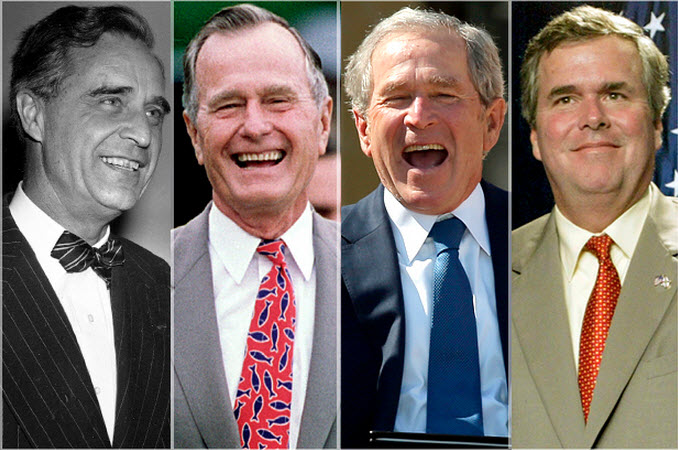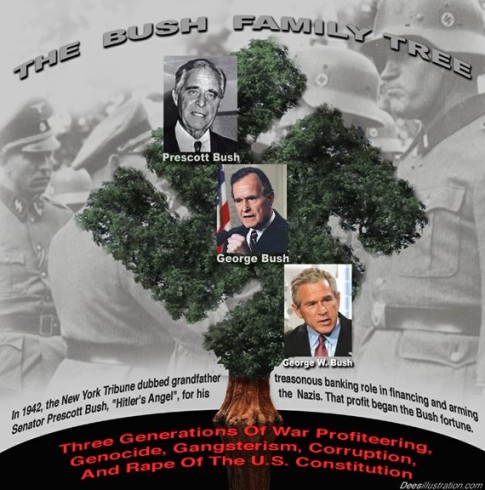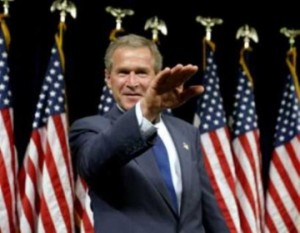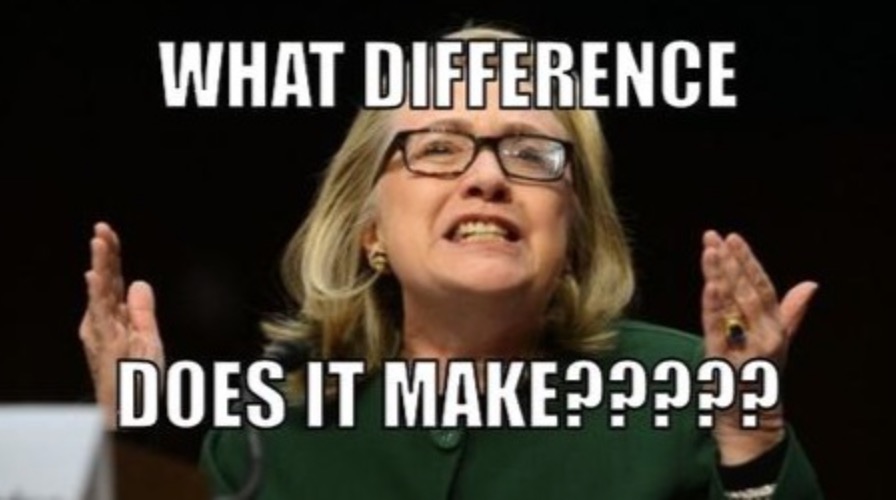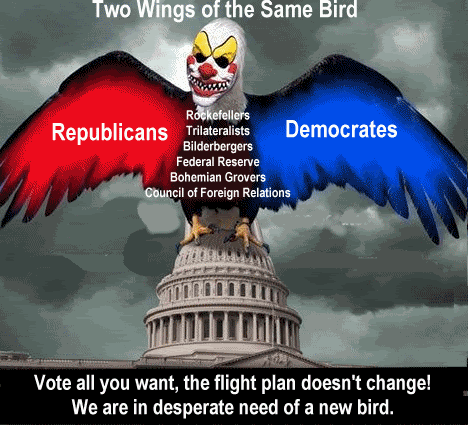– The Bush Family Goes “All In” For Number Three (With The Help Of Its Bankers) (ZeroHedge, June 28, 2015):
Money, they say, makes the world go round. So how’s $10 billion for you? That’s a top-end estimate for the record-breaking spending in this 1% presidential election campaign season. But is “season” even the right word, now that such campaigns are essentially four-year events that seem always to be underway? In a political world stuffed with money, it’s little wonder that the campaign season floats on a sea of donations. In the case of Jeb Bush, he and his advisers have so far had a laser-focus on the electorate they felt mattered most: big donors. They held off the announcement of his candidacy until last week (though he clearly long knew he was running) so that they could blast out of the gates, dollars-wise, leaving the competition in their financial dust, before the exceedingly modest limits to non-super PAC campaign fundraising kicked in.
And give Jeb credit — or rather consider him a credit to his father (the 41st president) and his brother (the 43rd), who had Iraq eternally on their minds. It wasn’t just that Jeb flubbed the Iraq Question when a reporter asked him recently (yes, he would do it all over again; no, he wouldn’t… well, hmmm…), but that Iraq is deeply embedded in the minds of his campaign team, too. His advisers dubbed the pre-announcement campaign they were going to launch to pull in the dollars a “shock-and-awe” operation in the spirit of the invasion of Iraq. Now, having sent in the ground troops, they clearly consider themselves at war. As the New York Times reported recently, the group’s top strategist told donors that his super PAC “hopes to ‘weaponize’ its fund-raising total for the first six months of the year.”
The money being talked about: $80-$100 million raised in the first quarter of 2015 and $500 million by June. If reached, these figures would indeed represent shock-and-awe fundraising in the Republican presidential race. As of now, there’s no way of knowing whether they’re fantasy figures or not, but here’s a clue to Jeb’s money-raising powers: according to the Washington Post, his advisers have been asking donors not to give more than a million dollars now; they are, that is, trying to cap donations for the moment. (As the Post’s Chris Cillizza wrote,“The move reflects concerns among Bush advisers that accepting massive sums from a handful of uber-rich supporters could fuel a perception that the former governor is in their debt.”) And having spent just about every pre-announcement day for months doing fundraisers and scouring the country for money, while preserving the fiction that he might not be interested in the presidency, Jeb, according to the New York Times, bragged to a group of donors that “he believed his political action committee had raised more money in 100 days than any other modern Republican political operation.”
Let’s not forget, of course, that we’re not talking about anyone; we’re talking about a Bush. We’re talking about the possibility of becoming number three (or rather Bush 45) in the Oval Office. We’re talking about what is, by now, a fabled money-shaking, money-making, money-raising machine of a family. We’re talking dynasty and when it comes to money and the Bushes (as with money and that other potential dynasty of our moment), no one knows more on the subject than Nomi Prins, former Wall Street exec and author of All the Presidents’ Bankers: The Hidden Alliances That Drive American Power. In her now ongoing TomDispatch series on the political dynasties of our moment, fundraising, and the Big Banks, think of her latest post as an essential backgrounder on the election you have less and less to do with, in which Wall Street, the Koch brothers, Sheldon Adelson, and the rest of the crew do most of the essential voting with their wallets.
All In
The Bush Family Goes for Number Three (With the Help of Its Bankers)
By Nomi Prins[This piece has been adapted and updated by Nomi Prins from her book All the Presidents’ Bankers: The Hidden Alliances That Drive American Power, recently out in paperback (Nation Books).]
It’s happening. As expected, dynastic politics is prevailing in campaign 2016. After a tease about as long as Hillary’s, Jeb Bush (aka Jeb!) officially announced his presidential bid last week. Ultimately, the two of them will fight it out for the White House, while the nation’s wealthiest influencers will back their ludicrously expensive gambit.
And here’s a hint: don’t bet on Jeb not to make it through the Republican gauntlet of 12 candidates (so far). After all, the really big money’s behind him. Last December, even though out of public office since 2007, he had captured the support of 73% of the Wall Street Journal’s “richest CEOs.” Though some have as yet sidestepped declarations of fealty, count on one thing: the big guns will fall into line. They know that, given his family connections, Jeb is their best path to the White House and they’re not going to blow that by propping up some Republican lightweight whose father and brother weren’t president, not when Hillary, with all her connections and dynastic power, will be the opponent. That said, in the Bush-Clinton battle to come, no matter who wins, the bankers and billionaires will emerge victorious.
The issue of political blood and family lines in Washington is not new. There have been four instances in our history in which presidents have been bonded by blood. Our second president John Adams and eighth president John Quincy Adams were father and son. Our ninth president William Henry Harrison and our 23rd president Benjamin Harrison were grandfather and grandson. Theodore and Franklin Delano Roosevelt were cousins. And then, of course, there were our 41st and 43rd presidents, George H.W. and George W.
If Jeb becomes the 45th president, it will be the first time that three administrations share the same blood and “dynastic” will have a new meaning in America.
The Bush Legacy
The Bush political-financial legacy began when President Ronald Reagan chose Jeb’s father, George H.W., as his vice president. Reagan was also the first president to choose a Wall Street CEO, Donald Regan, as Treasury secretary. Then-CEO of Merrill Lynch, he happened to be a Bush family friend. And talk about family tradition: once upon a time (in 1900, to be exact), Jeb’s great-grandfather, George Herbert Walker, founded G.W. Walker & Company. It was eventually acquired by — you guessed it! — Merrill Lynch, which was consumed by Bank of America at the height of the 2008 financial crisis.
That merger was pressed by, among others, George W. Bush’s Treasury Secretary (and former Goldman Sachs chairman and CEO), Hank Paulson. It helped John Thain, Paulson’s former number two at Goldman Sachs, who was by then Merrill Lynch’s CEO, out of a tight spot. Now chairman and CEO of CIT Group, Thain is also a prominent member of the Republican Party who sponsored high-ticket fundraisers for John McCain during his 2008 campaign. Expect him to be there for Jeb. Paulson endorsed Jeb for president on April 15th. That’s how these loops go.
As vice president, George H.W. co-ran a task force with Donald Regan dedicated to breaking down the constraints of the 1933 Glass-Steagall Act, so that Wall Street banks could become ever bigger and more complex. Once president, Bush promoted deregulation, while reconfirming Alan Greenspan, who did the same, as the chairman of the Federal Reserve. In 1999, after President Bill Clinton (Hillary!) finished the job that Bush had started by overseeing the repeal of Glass-Steagall, banks began merging like mad and engaging in increasingly risky and opaque practices that led to the financial crisis that came to a head in George W.’s presidency. In other words, it’s a small world at the top.
The meaning of all this: no other GOP candidate has Jeb’s kind of legacy political-financial power. Period. To grasp the interconnections between the Bush family and Wall Street that will put heft and piles of money behind his candidacy, however, it’s necessary to step back in time and see just how his family helped lead us to this moment of his.
Bush Wins
By the time George H.W. Bush became president on January 20, 1989, the economy was limping. Federal debt stood at $2.8 trillion. The savings and loan crisis had escalated. Still, his deregulatory financial policies remained in sync with those of the period’s most powerful bankers, notably Citicorp chairman John Reed, Chase (now JPMorgan Chase) Chairman Willard Butcher, JPMorgan chief Dennis Weatherstone, and Bank of America Chairman Tom Clausen.
With the economic odds stacked against him, Bush also remained surrounded by his most loyal, business-friendly companions in Washington, who either had tight relationships with Wall Street or came directly from there. In a preordained arrangement with President Reagan, Bush retained Nicholas Brady, the former chairman of the board of the blue-blood Wall Street investment bank Dillon, Read & Co., as Treasury secretary.
Their ties, first established on a tennis court, extended to Wall Street and back again. In 1977, after Bush had left the directorship of the CIA, Brady even offered him a position at Dillon, Read & Co. Though he didn’t accept, Bush later enlisted Brady to run his 1980 presidential campaign and suggested him as interim senator for New Jersey in 1982. The press dubbed Brady Bush’s “official confidant.”
The new president appointed another of his right-hand men, Richard Breeden (who had drafted a “Blueprint for Reform” of the banking industry as directed by a task force co-headed by Bush), as his assistant for issues analysis and later as head of the Securities and Exchange Commission (SEC). Then, on February 6, 1989, Bush unveiled his plan to rescue the ailing savings and loan (S&L) banks. Initial bailout estimates for 223 firms were put at $40 billion. It only took the Bush administration two weeks to raise that figure to $157 billion. On the offensive, Brady stressed that this proposal wasn’t a bailout. Instead, it represented “the fulfillment of the Federal Government’s commitment to depositors.”
A few months later, under Alan Greenspan’s Fed, JPMorgan Securities, the investment banking subsidiary of JPMorgan Chase, became the first bank subsidiary since the Great Depression to lead a corporate bond underwriting. Over the next decade, commercial banks would issue billions of dollars of corporate debt on behalf of energy and public utility companies as a result of Greenspan’s decision to open that door and Bush’s deregulatory stance in general. A chunk of it would implode in fraud and default after Bush’s son became president in 2001.
The S&L Blowout
The deregulation of the S&L industry between 1980 and 1982 had enabled those smaller banks, or thrifts — focused on taking deposits and providing mortgages — to compete with commercial banks for depositors and to invest that money (and money borrowed against it) in more speculative real estate ventures and junk bond securities. When those bets soured, the industry tanked. Between 1986 and 1989, 296 thrifts failed. An additional 747 would shut down between 1989 and 1995.
Among those, Silverado Banking went bankrupt in December 1988, costing taxpayers $1.3 billion. Neil Bush, George H.W.’s son, was on the board of directors at the time. He was accused of giving himself a loan from Silverado, but denied all wrongdoing.
George H.W.’s second son, Jeb Bush, had already been dragged through the headlines in late 1988 for his real estate relationship with Miguel Recarey Jr., a Cuban-American mogul who had been indicted on one charge of fraud and was suspected of racking up to $100 million worth of Medicare-related fraud charges.
Meanwhile, the president was crafting his bailout plan to stop the S&L bloodletting. On August 9, 1989, he signed the Financial Institution Reform, Recovery, and Enforcement Act, which proved a backdoor boon for the big commercial banks. Having helped stuff the S&Ls with toxic real estate products, they could now profit by selling the bonds that were constructed as part of the bailout plan, while the government subsidized the entire project. Within six years, the Resolution Trust Corporation and the Federal Savings and Loan Insurance Corporation had sold $519 billion worth of assets for 1,043 thrifts that had gone belly up. Key Wall Street banks were involved in distributing those assets and so made money on financial destruction once again. Washington left the public on the hook for $124 billion in losses.
The Bush administration and the Fed’s response to the S&L crisis (as well as to a concurrent third-world debt crisis) was to subsidize the banking system with federal and multinational money. In this way, a policy of privatizing bank profits and socializing their losses and risks became embedded in the American political system.
The New Banking Game in Town: “Modernization”
The S&L trouble sparked a broader credit crisis and recession. Congress was, by then, debating the “modernization” of the financial services industry, which in practice meant breaking down remaining barriers within institutions that had separated deposits and loans from securities creation and trading activities. This also meant allowing commercial banks to expand into nontraditional banking activities, including insurance provision and fund management.
The Bush administration aided the bankers by advocating the repeal of key elements of the Glass-Steagall Act. Related bills to dismantle that Depression-era act won the support of the House and Senate banking committees in the fall of 1991, though they were defeated in the House in a full vote. Still, the writing was on the wall. What a Republican president had started, a Democratic one would soon complete.
In the meantime, the Bush administration was covering all the bases when it came to the repeal of Glass-Steagall, which would be the nail in the coffin of decades of banking constraint. As commercial bankers pushed to enter non-banking businesses, Richard Breeden, Bush’s SEC chairman, began championing the other side of the Glass-Steagall divide — fighting, that is, for the rights of investment banks to own commercial banks. And little wonder, since such a deregulation of the financial system meant a potential expansion of Breeden’s power: the SEC would be tasked with monitoring the growing number of businesses that banks could enter.
Meanwhile, Wendy Gramm, head of the Commodity Futures Trading Commission (CFTC), promoted another goal the bankers wanted: unconstrained derivatives trading. Gramm had first been appointed chair of the CFTC in 1988 by Reagan (who called her his “favorite economist”) and was then reappointed by Bush. She was determined to push for unregulated commodity futures and swaps — in part in response to lobbying from a Texas-based energy trading company, Enron, whose name would grow far more familiar to Americans in the years to come. While awaiting legislative approval, bankers started sending their trading exemption requests to Gramm and she began granting them.
9/11 Overshadows Enron
In early 2001, in the fading light of the rosy Clinton economy and an election result validated by the Supreme Court, the second President Bush entered the White House. A combination of Glass-Steagall repeal and the deregulation of the energy and telecom sectors under Clinton catalyzed a slew of mergers that consolidated companies and power in those industries upon fabricated books. The true state of the economy, however, remained well hidden, even as it teetered on a flimsy base of fraud, inflated stocks, and bank-created debt. In those years, the corporate and banking world still appeared glorious amid so many mergers. But the bankers’ efforts to support those transactions would soon give way to a spate of corporate bankruptcies.
It was the Texas-based energy-turned-trading company Enron that would emerge as the poster child for financial fraud in the early 2000s. It had used the unregulated derivatives markets and colluded with bankers to create a slew of colorfully named offshore entities through which the company piled up debt, shirked taxes, and hid losses. The true status of Enron’s fictitious books and those of other corporate fraudsters nonetheless remained unexamined in part because another crisis garnered all the attention. The 9/11 attacks at the World Trade Center, blocks away from where many of Enron’s trading partners were headquartered (including Goldman Sachs, where I was working that day), provided the banking industry with a reprieve from probes. The president instead called on bankers to uphold national stability in the face of terrorism.
On September 16, 2001, George W. famously merged financial and foreign policy. “The markets open tomorrow,” he said. “People go back to work and we’ll show the world.” To assist the bankers in this mission, Bush-appointed SEC chairman Harvey Pitt waived certain regulations, allowing corporate executives to prop up their share prices as part of a plan to demonstrate national strength by elevating market levels.
That worked — for about a minute. On October 16, 2001, Enron posted a $681 million third-quarter loss and announced a $1.2 billion hit to shareholders’ equity. The reason: an imploding pyramid of fraudulent transactions crafted with banks like Merrill Lynch. The bankers were now potentially on the hook for billions of dollars, thanks to Enron, a client that had been bulked up through the years with bipartisan support.
Amid this financial turmoil, Bush was focused on retaliation for 9/11. On January 10, 2002, he signed a $317.2 billion defense bill. In his State of the Union address, he spoke of an “Axis of Evil,” of fighting both the terrorists and a strengthening recession, but not of Enron or the dangers of Wall Street chicanery.
In 2001 and again in 2002, however, corporate bankruptcies would hit new records, with fraud playing a central role in most of them. Telecom giant WorldCom, for instance, was found to have embellished $11 billion worth of earnings. It would soon supplant Enron as America’s biggest fraud of the moment.
Bush Takes Action
On July 9th, George W. finally unveiled a plan to “curb” corporate crime in a speech given in the heart of New York’s financial district. Taking the barest of swipes at his Wall Street friends, he urged bankers to provide honest information to investors. The signals were now clear: bankers had nothing to fear from their commander in chief. That Merrill Lynch, for example, was embroiled in the Enron scandal was something the president would ignore — hardly a surprise, since the company’s alliances with the Bush family stretched back decades.
Three weeks later, he would sign the Sarbanes-Oxley Act, purportedly ensuring that CEOs and CFOs would confirm that the information in their SEC filings had been presented truthfully. It would prove a toothless and useless deterrent to fraud.
And then the president acted: on March 19, 2003, he launched the invasion of Iraq with a shock-and-awe shower of cruise missiles into the Iraqi night sky. Two days later, by a vote of 215 to 212, the House approved his $2.2 trillion budget, including $726 billion in tax cuts. Shortly thereafter — a signal to the banking industry if there ever was one — he appointed former Goldman Sachs Chairman Stephen Friedman director of the National Economic Council, the same role another Goldman Sachs alumnus, former co-Chairman Robert Rubin, had played for Bill Clinton.
By the end of 2003, grateful bankers were already amassing funds for Bush’s 2004 reelection campaign. A bevy of Wall Street Republicans, including Goldman Sachs Chairman and CEO Henry Paulson, Bear Stearns CEO James Cayne, and Goldman Sachs executive George Herbert Walker IV (the president’s second cousin), became Bush “Pioneers” by raising at least $100,000 each.
The top seven financial firms officially raised nearly three million dollars for George W.’s campaign. Merrill Lynch emerged as his second biggest corporate contributor (after Morgan Stanley), providing more than $586,254. The firm’s enthusiasm wasn’t surprising. Donald Regan had been its chairman and the Bush-founded investment bank G.H. Walker and Company, which employed members of the family over the decades, had been absorbed into Merrill in 1978. Merrill Lynch CEO Earnest “Stanley” O’Neal received the distinguished label of “Ranger” for raising more than $200,000 for Bush’s reelection campaign. It was a sign of the times that O’Neal and Cayne hosted Bush’s first New York City reelection fundraiser in July 2003.
Government by Goldman Sachs for Goldman Sachs
The bankers helped tip the scales in Bush’s favor. On November 3, 2004, he won his second term in a tight election. By now, bankers from Goldman Sachs had saturated Washington. New Jersey Democrat Jon Corzine, a former Goldman Sachs chairman and CEO, was on the Senate Banking Committee. Joshua Bolten, a former executive director at the Goldman Sachs office in London, was director of the Office of Management and Budget. Stephen Friedman, former Goldman Sachs chairman, was one of George W.’s chief economic advisers as the director of the National Economic Council. (He would later become chairman of the New York Federal Reserve Board, only to resign in May 2009 amid conflict of interest charges concerning the pile of Goldman Sachs shares he held while using his post to aid the company during the financial crisis.)
Meanwhile, from 2002 to 2007, under George W.’s watch, the biggest U.S. banks would fashion nearly 80% of the approximately $14 trillion worth of global mortgage-backed securities (MBS), asset-backed securities, collateralized debt obligations, and other kinds of packaged assets created in those years. And subprime loan packages would soon become the fastest-growing segment of the MBS market. In other words, the financial products exhibiting the most growth would be the ones containing the most risk.
George W. would also pick Ben Bernanke to replace Alan Greenspan as chairman of the Federal Reserve. Bernanke made it immediately clear where his loyalties lay, stating, “My first priority will be to maintain continuity with the policies and policy strategies during the Greenspan years.”
In 2006, two years after persuading the SEC to adopt rules that enabled many of the “assets” being created to be undercapitalized and underscrutinized, the president selected former Goldman Sachs CEO Henry Paulson to be his third Treasury secretary. Joshua Bolten, who had by then had become White House Chief of Staff, arranged the pivotal White House meeting between the two men that sealed the deal. As Bush wrote in his memoir, Decision Points, “Hank was slow to warm to the idea of joining my cabinet. Josh eventually persuaded Hank to visit with me in the White House. Hank radiated energy and confidence. Hank understood the globalization of finance, and his name commanded respect at home and abroad.”
Under Bush, Paulson, and Bernanke, the banking sector would buckle and take the global economy down with it.
Goldman Trumps AIG
Insurance goliath AIG stood at the epicenter of an increasingly interconnected financial world deluged with junky subprime assets wrapped up with derivatives. When rating agencies Fitch, S&P, and Moody’s downgraded the company’s credit worthiness on September 15, 2008, they catalyzed $85 billion worth of margin calls. If AIG couldn’t find that money, Paulson warned the president, the firm would not only fail, but “bring down major financial institutions and international investors with it.” According to Bush’s memoir , Paulson convinced him. “There was only one way to keep the firm alive,” he wrote. “The federal government would have to step in.”
The main American recipients of AIG’s bailout would, in fact, be legacy Bush-allied firms: Goldman Sachs ($12.9 billion), Merrill Lynch ($6.8 billion), Bank of America ($5.2 billion), and Citigroup ($2.3 billion). Lehman crashed, but Merrill Lynch and AIG were saved. The bankers with the strongest alliances to the Bush family (and the White House in general) needed AIG to survive. And it did. But the bloodletting wasn’t over.
On September 18, 2008, George W. would tell Paulson, “Let’s figure out the right thing to do and do it.” He would later write, “I had made up my mind: the U.S. government was going all in.” And he meant it. During his last months in office, the Big Six banks (and marginally other institutions) would thus be subsidized by an “all-in” program designed by Bernanke, Paulson, and Geithner — and later endorsed by President Barack Obama.
The bankers’ unruliness had, however, already crippled the real economy. Over the next few months, Bank of America, Citigroup, and AIG all needed more assistance. And in that year, the Dow Jones Industrial Average would lose nearly half its value. At the height of the bailout period, $19.3 trillion in subsidies were made available to keep (mostly) American bankers going, as well as government-sponsored enterprises like Fannie Mae and Freddie Mac.
As George W. headed back to Texas, the economy and markets went into free fall.
The Money Behind Jeb
Jump seven years ahead and, with the next Bush on the rise and the money once again flowing in, it’s still the age of bankers. Jeb already has three mega super PACs — Millennials for Jeb, Right to Rise, and Vamos for Jeb 2016 — under his belt. His Right to Rise Policy Solutions group, which, as a 501(c)(4) nonprofit, is not even required to disclose the names of its donors, no less the size of their contributions, is lifting his contribution tally even higher. None of these groups have to adhere to contribution limits and the elite donors who contribute to them often prove highly influential. After all, that’s where the money really is. In the 2012 presidential election, the top 100 individual contributors to super PACs and their spouses represented just 1% of all donors, but gave a staggering 67% of the money.
Of those, Republican billionaire Sheldon Adelson and his wife, Miriam, donated $92.8 million to conservative groups, largely through “outside donor groups” like super PACs that have no contribution limits. Texas billionaire banker mogul Harold Simmons and his wife, Annette, gave $26.9 million, and Texas billionaire homebuilder Robert Perry coughed up $23.95 million. Nebraska billionaire (and founder of the global discount brokerage TD Ameritrade) John Joe Ricketts dished out $13.05 million. Despite some early posturing around other candidates with fewer legacy ties, these heavy hitters could all end up behind Bush 45. Dynasties, after all, establish the sort of connections that lie in wait for the next moment of opportune mobilization.
“All in for Jeb” is the mantra on Jeb’s official website and in a sense “all in,” especially when it comes to national bankers, has been something of a mantra for the Bush family for decades. With a nod to his two-term record as Florida governor, Jeb put it this way: “We will take command of our future once again in this country. I know we can fix this. Because I’ve done it.”
Based on Bush family history, by “we” he effectively meant the family’s billionaire and millionaire donors and its cavalcade of friendly bankers. Topping that list, though as yet undeclared — give him a minute — sits Adelson, who is personally and ideologically close to George W. In April, the former president was paid a Clintonian speaking fee of $250,00 for a keynote talk before the Republican Jewish Coalition meeting at Adelson’s Las Vegas resort. While Adelson has expressed concerns about Jeb’s lack of hawkishness on Israel when compared to his brother, that in the end is unlikely to prove an impediment. Jeb is making sure of that. He recently told a gathering of wealthy New York donors that, when it came to Israel, his top adviser is his brother. (“If you want to know who I listen to for advice, it’s him.”)
Let’s be clear. The Bush family is all in on Jeb and its traditional banking allies are not likely to be far behind. There is tradition, there are ties, there is a dynasty to protect. They are not planning to lose this election or leave the family with a mere two presidents to its name.
The Wall Street crowd began rallying behind Jeb well before his candidacy was official. Private equity titan Henry Kravis hosted a 25-guest $100,000-per-head gathering at his Park Avenue abode in February, one of six events with the same entry fee. In March, Jeb had his first Goldman Sachs $5,000-per-person event at the Ritz Carlton in New York City, organized by Dina Powell, Goldman Sachs Foundation head and George W. Bush appointee for assistant secretary of state. A more exclusive $50,000 per head event was organized by Goldman Sachs exec, Jim Donovan, a key fundraiser and adviser for Mitt Romney who is now doing the same for Jeb.
And then there’s the list of moneyed financiers with fat wallets still to get behind Jeb. New York hedge fund billionaire Paul Singer, who donated more than any other conservative in the 2014 election, has yet to swoop in. Given the alignment of his foreign financial policy views and the Bush family’s, however, it’s just a matter of time.
With the latest total super PAC figures still to be disclosed, we do know that Jeb’s Right to Rise super PAC claims to have raised $17 million from the tri-state (New York, New Jersey, and Connecticut) area alone so far. Its head, Mike Murphy, referred to its donors in a call last week as “killers” he was about to “set loose.” He intimated that the July disclosures would give opponents “heart attacks.” Those are fighting words.
Sure, all dynasties end, but don’t count on the Bush-Banker alliance going belly up any time soon. Things happen in this country when mountains of money begin to pile up. This time around, the Bush patriarchy will call in every chip. And know this: Wall Street will be going “all in” for this election, too. Jeb(!) and Hillary(!) will likely split that difference in the primaries, then duke it out in 2016. Along the way, every pretense of mixing it up with the little people will be matched by a million-dollar check to a super PAC. The cash thrown about in this election will be epic. It’s not the fate of two parties but of two dynasties that’s at stake.
